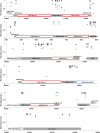Non-coding RNA may be associated with cytoplasmic male sterility in Silene vulgaris
- PMID: 28369520
- PMCID: PMC5444436
- DOI: 10.1093/jxb/erx057
Non-coding RNA may be associated with cytoplasmic male sterility in Silene vulgaris
Abstract
Cytoplasmic male sterility (CMS) is a widespread phenomenon in flowering plants caused by mitochondrial (mt) genes. CMS genes typically encode novel proteins that interfere with mt functions and can be silenced by nuclear fertility-restorer genes. Although the molecular basis of CMS is well established in a number of crop systems, our understanding of it in natural populations is far more limited. To identify CMS genes in a gynodioecious plant, Silene vulgaris, we constructed mt transcriptomes and compared transcript levels and RNA editing patterns in floral bud tissue from female and hermaphrodite full siblings. The transcriptomes from female and hermaphrodite individuals were very similar overall with respect to variation in levels of transcript abundance across the genome, the extent of RNA editing, and the order in which RNA editing and intron splicing events occurred. We found only a single genomic region that was highly overexpressed and differentially edited in females relative to hermaphrodites. This region is not located near any other transcribed elements and lacks an open-reading frame (ORF) of even moderate size. To our knowledge, this transcript would represent the first non-coding mt RNA associated with CMS in plants and is, therefore, an important target for future functional validation studies.
Keywords: Cytoplasmic male sterility; Silene vulgaris; editing; mitochondrion; non-coding RNA; splicing; transcriptome..
© The Author 2017. Published by Oxford University Press on behalf of the Society for Experimental Biology.
Figures





Similar articles
-
The Role of Non-Coding RNAs in Cytoplasmic Male Sterility in Flowering Plants.Int J Mol Sci. 2017 Nov 16;18(11):2429. doi: 10.3390/ijms18112429. Int J Mol Sci. 2017. PMID: 29144434 Free PMC article. Review.
-
Homologous recombination changes the context of Cytochrome b transcription in the mitochondrial genome of Silene vulgaris KRA.BMC Genomics. 2018 Dec 4;19(1):874. doi: 10.1186/s12864-018-5254-0. BMC Genomics. 2018. PMID: 30514207 Free PMC article.
-
Differentially Expressed Genes Shared by Two Distinct Cytoplasmic Male Sterility (CMS) Types of Silene vulgaris Suggest the Importance of Oxidative Stress in Pollen Abortion.Cells. 2020 Dec 16;9(12):2700. doi: 10.3390/cells9122700. Cells. 2020. PMID: 33339225 Free PMC article.
-
Variation in plastid genomes in the gynodioecious species Silene vulgaris.BMC Plant Biol. 2019 Dec 19;19(1):568. doi: 10.1186/s12870-019-2193-0. BMC Plant Biol. 2019. PMID: 31856730 Free PMC article.
-
Mitochondrial regulation of flower development.Mitochondrion. 2008 Jan;8(1):74-86. doi: 10.1016/j.mito.2007.09.006. Epub 2007 Dec 3. Mitochondrion. 2008. PMID: 18054525 Review.
Cited by
-
Evolution of sex determination and heterogamety changes in section Otites of the genus Silene.Sci Rep. 2019 Jan 31;9(1):1045. doi: 10.1038/s41598-018-37412-x. Sci Rep. 2019. PMID: 30705300 Free PMC article.
-
Noncoding RNA: An Insight into Chloroplast and Mitochondrial Gene Expressions.Life (Basel). 2021 Jan 13;11(1):49. doi: 10.3390/life11010049. Life (Basel). 2021. PMID: 33450961 Free PMC article. Review.
-
Mitochondrial genome and transcriptome analysis of five alloplasmic male-sterile lines in Brassica juncea.BMC Genomics. 2019 May 8;20(1):348. doi: 10.1186/s12864-019-5721-2. BMC Genomics. 2019. PMID: 31068124 Free PMC article.
-
The Role of Non-Coding RNAs in Cytoplasmic Male Sterility in Flowering Plants.Int J Mol Sci. 2017 Nov 16;18(11):2429. doi: 10.3390/ijms18112429. Int J Mol Sci. 2017. PMID: 29144434 Free PMC article. Review.
-
Landscape of RNA editing reveals new insights into the dynamic gene regulation of spermatogenesis.Cell Cycle. 2019 Dec;18(23):3351-3364. doi: 10.1080/15384101.2019.1676584. Epub 2019 Oct 9. Cell Cycle. 2019. PMID: 31594448 Free PMC article.
References
-
- Arrieta-Montiel MP, Mackenzie SA. 2011. Plant mitochondrial genomes and recombination. In: Kempken F, ed. Plant mitochondria. New York:Springer, 65–82.
-
- Bernasconi G, Antonovics J, Biere A, et al. 2009. Silene as a model system in ecology and evolution. Heredity 103, 5–14. - PubMed
Publication types
MeSH terms
Substances
LinkOut - more resources
Full Text Sources
Other Literature Sources

